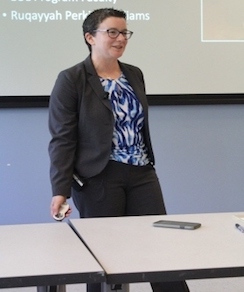Superintendents of school districts are often met with resistance—and even blame—by school-board members when they bring up student inequity issues that are occurring in their districts—not exactly an ideal situation when trying to address longstanding, systemic problems.
Dr. Rachel Roegman broached this challenge during a May 7 talk at the College of Education at Illinois, where she discussed her 10-year longitudinal study with the New Jersey Network of Superintendents, a group she has been a part of since 2008. Roegman is currently an assistant professor in the Department of Education Policy, Organization & Leadership (EPOL) at Illinois and a 2018-19 Hardie Faculty Fellow.
According to Roegman, there is an increasing push for superintendents to be both instructional leaders who are guiding classroom curriculum and teacher evaluation, and leaders who are simultaneously engaging in issues surrounding social-justice, equity, and culturally responsive practices. Assimilating instruction and equity in leadership practice so that all students in the building learn, and demographics don’t predict outcomes, can be difficult for superintendents, who have isolated positions in which professional development opportunities are sparse, Roegman said.
“One of the things we see in the literature is these two activities are really separate,” Roegman said in the talk. “The work in instruction is happening in one area, and the work on thinking about equity, looking at data, are separate.”
To mollify that, the study by Roegman and her fellow facilitators in the New Jersey network has focused on developing superintendents and principals who make equity a priority and are adept at dealing with the topic. Members of the network have developed a practice called “equity visits,” a practice in which a host school recognizes an equity issue in the building and requests either internal or external assistance to help examine and address the problem.
Roegman said participants in equity visits present school leaders with “hard questions” after observing instructional practice and interviewing various stakeholders. They are then expected to reflect upon what they witnessed and see how it may apply to their own school.
“The goal of equity visits is for administrators to take their work on equity and their work on instruction and bring them together,” Roegman said.
The work has culminated into a book written by Roegman and several others in the network titled Equity Visits: A New Approach to Supporting Equity-Focused School Leadership, which is scheduled for an October release by Corwin Press. The book delves deeply into examples of equity visits and what they look like.
Roegman said equity visits are only successful if the school leaders and the learning community being observed have a commitment to equity. Typical hindrances when talking about racial issues, she said, include understating matters related to race, an unwillingness of white participants to talk about race, and a “culture of nice” in which educators do not give or expect critical feedback. Relational trust, professional accountability, and reflective practice are all essential in developing a learning community that can tackle these obstacles, she said.
Roegman concluded her talk by asking audience members to vote on their favorite cover choice for the future book. She also held a question-and-answer session, responding to questions about the definition of equity and what inequities superintendents were most comfortable talking about. The EPOL scholar also responded to inquiries about the high number of students of color who are referred to special education, and the fact that race isn’t brought up in these circumstances, as well as the process of organizing visits utilizing disaggregated data on race that are fundamentally complex.
Watch the video of Dr. Roegman’s presentation.
